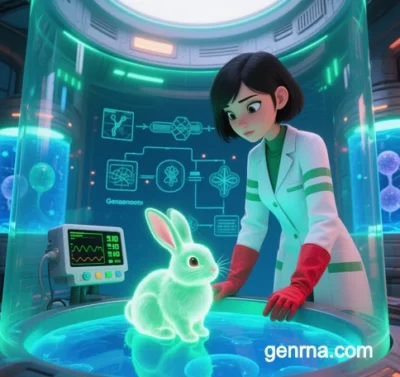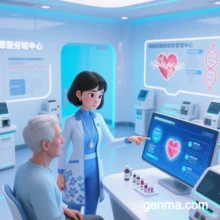
Latest Advances in Gene-Edited Animal Models in Medical Research
(2025 Comprehensive Review)
Gene-edited animal models have become indispensable tools in modern medical research, enabling precise simulation of human disease mechanisms to advance basic research, drug development, and therapeutic strategies. This review systematically analyzes breakthroughs across five dimensions: technological innovation, model development, applications, ethical challenges, and future trends.
I. Technological Breakthroughs: Evolution of Gene-Editing Tools
- CRISPR-Cas9 Enhancements:
- Base and Prime Editing: CRISPR-derived tools (e.g., BE4max, PE2) enable precise edits without double-strand breaks, reducing off-target effects (below 0.1%) and repairing single-nucleotide mutations in primates (e.g., sickle cell anemia).
- Multiplex Editing: Co-delivery of multiple gRNAs allows simultaneous knockout/knock-in of genes in single embryos (e.g., polygenic cancer models) with over 80% efficiency.
- High-Throughput Platforms:
- Automated Embryo Injection: AI-optimized microinjection reduces mouse model generation time to 6 weeks (from months) and cuts costs by 60%.
- In Vivo Editing: Lipid nanoparticles (LNPs) deliver CRISPR components to adult animal organs (e.g., liver), bypassing embryo manipulation.
- Spatiotemporal Control:
- Optogenetic CRISPR: Light-sensitive proteins (e.g., LOV2) regulate Cas9 activity for tissue-specific editing in zebrafish (e.g., heart).
- Inducible Systems: Tet-On/Off promoters combined with CRISPR dynamically modulate gene expression to model disease progression stages.
II. Model Innovations: Cross-Species and Complex Disease Simulation
- Large Mammalian Models:
- Gene-Edited Pigs:
- Xenotransplantation: PERV and MHC-I knockout pigs serve as immunocompatible organ donors, entering clinical trials for heart transplants.
- Neurodegeneration: SNCA-edited pigs replicate α-synuclein aggregation and motor deficits in Parkinson’s disease.
- Non-Human Primates: APP/PSEN1-edited cynomolgus monkeys model Alzheimer’s pathology (Aβ plaques, Tau tangles).
- Complex Disease Models:
- Immunodeficient Models:
- Humanized SCID Mice: Support HIV infection and CAR-T therapy testing after human CD34+ stem cell engraftment.
- IL2RG/PRKDC Double-KO Rabbits: Assess long-term safety of gene therapies for X-SCID, overcoming murine immune limitations.
- Metabolic Syndrome: LEPR-KO rats develop obesity, insulin resistance, and fatty liver for GLP-1 agonist evaluation.
- Dynamic Pathology Modeling:
- Conditional Oncogenesis: Cre-LoxP-induced KRAS G12D mutations in adult mouse lungs track real-time tumor evolution and immune microenvironment changes.
- Accelerated Aging: TERT knockout with oxidative stress halves mouse lifespan for anti-aging drug screening.
III. Applications: From Basic Research to Clinical Translation
- Disease Mechanism Elucidation:
- Neurodegeneration:
- APOE4-edited macaques reveal how ApoE4 disrupts the blood-brain barrier to heighten Alzheimer’s risk.
- SOD1-mutant rabbits model ALS motor neuron degeneration, showing glial activation precedes symptom onset.
- Cancer Immunotherapy: PD-1/CTLA-4 double-KO mice validate synergistic effects of checkpoint inhibitor combinations.
- Drug Development:
- Gene Therapy Safety: AAV9-mediated SMN1 delivery in SMA pigs confirms spinal cord targeting feasibility.
- Personalized Models: Patient-derived xenograft (PDX) mice guide precision chemotherapy and targeted therapy.
- Regenerative Medicine:
- Organ Regeneration: FAH-KO pig livers transplanted with human hepatocytes regenerate functional tissue for liver failure treatment.
- Stem Cell Therapy: Gene-edited hematopoietic stem cells show long-term engraftment in SCID monkeys.
IV. Ethical Challenges and Alternatives
- Animal Welfare Concerns:
- Off-Target Effects: CRISPR edits (e.g., Mecp2 in mice causing epilepsy) necessitate stringent whole-genome sequencing.
- Ecological Risks: Germline-edited models (e.g., gene-drive mosquitoes) raise regulatory debates.
- Alternative Models:
- Organ-on-a-Chip: Human lung chips model COPD pathology, replacing mice for MMP inhibitor testing.
- AI Predictions: AlphaFold3 and molecular dynamics reduce animal use by predicting mutant protein structures.
V. Future Trends: Precision and Intelligence
- Personalized Disease Models: Patient-derived iPSC-animal chimeras (e.g., CFTR ΔF508) enable individualized mutation studies.
- Multi-Omics Integration: Single-cell spatiotemporal transcriptomics map neurovascular interactions in stroke models.
- Ethical-Tech Synergy: Upgraded 3R principles (Reduction, Refinement, Replacement) via organ chips and AI.
Conclusion and Outlook
Gene-edited animal models are transitioning from “disease simulators” to “precision medical platforms.” Despite ethical and technical hurdles, their role in unraveling complex pathologies, accelerating drug discovery, and advancing regenerative medicine remains irreplaceable. The integration of cross-species editing, dynamic control systems, and organoid-AI platforms will usher in a new era of predictable, customizable, and translatable medical research.
Data sourced from public references. For collaborations or domain inquiries, contact: chuanchuan810@gmail.com.






